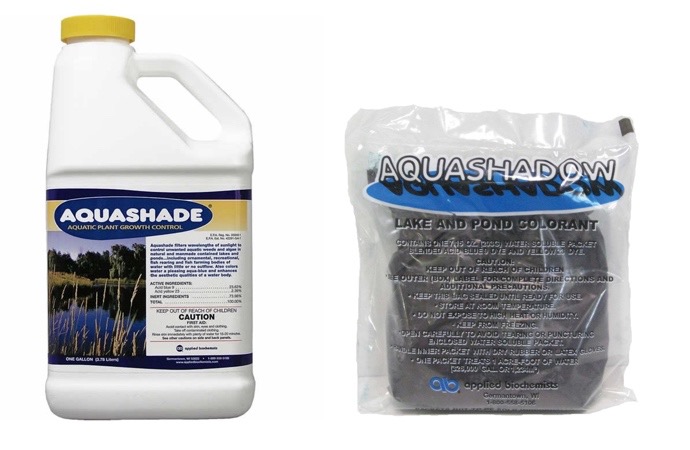Dyes for Pond Weed Management
Introduction
Aquatic dyes (Figure 1) reduce the growth of submerged plants and algae by reducing light levels. They are a preventative measure and should not be applied when submerged plants or algae are abundant. Dyes should only be applied in the early spring, before plants or algae begin growing or after a herbicide has been applied to greatly reduce plant or algae abundance. When considering use of herbicides, work with your Extension educator to identify the problem plant and take the precautions described in L-455.
Dyes are usually most effective when used together with other management measures. These are recommended by your county Extension agriculture educator, based on your pond’s characteristics and your situation.
Figure 1. Pond dyes come in both liquid and powder forms. (Mention of a product name or inclusion of a product image does not constitute endorsement. Failing to do so does not imply anything negative about a product.)
Application is relatively simple. Apply the amount directed by the label. It will spread and diffuse across the pond. Take care not to apply more than the label recommends: it is simple to add more but usually impractical to dilute if you overapply. Applying from a boat along the midline of the pond can be considered if there are animals who might be drinking the water. This will allow it to dilute before it reaches shoreline areas.
After the dye has been applied and allowed to fully diffuse throughout the pond:
- Consumption by livestock is permitted.
- Irrigation from dye treated ponds is allowable.
- Swimming is allowable.
- Fish from dyed ponds are safe to consume.
Avoid these Common Mistakes
- Do not apply when a pond has a dense green color due to algae. When this is done,
unsightly algal scums often result, and sometimes a low oxygen fish kill will occur
as
the algae decays. - Do not use in ponds that frequently overflow.
- Do not use dyes in ponds where fishing is important. Lower light levels reduce the production of insects and other food items essential for fish.
- Take steps to protect your skin and clothes when applying the product.
- Do not forget to reapply as the label directs. Dye breaks down over time and/or is
flushed out of ponds when there is an overflow. A spring, summer, fall application
schedule is typical. Failure to reapply on the recommended schedule is a common cause
of complaints about dyes not working.
To help you know when a dye reapplication is needed, follow these steps:
- Make the first application using the amount that the label directs.
- After the dye is fully dispersed, slowly submerse a weighted white object in the pond on a sunny day.
- Measure the number of inches at which it disappears. This is your reference number.
- Whenever you wonder if a reapplication is needed, submerse that same white object and see how the depth of disappearance compares to the reference number. If the measured depth is 25% or higher than the reference number, add more dye to restore the original concentration.
- Aquatic dyes are labeled products approved for use in ponds by the EPA. Read and follow all directions in the label. The applicator assumes responsibility for any application.

